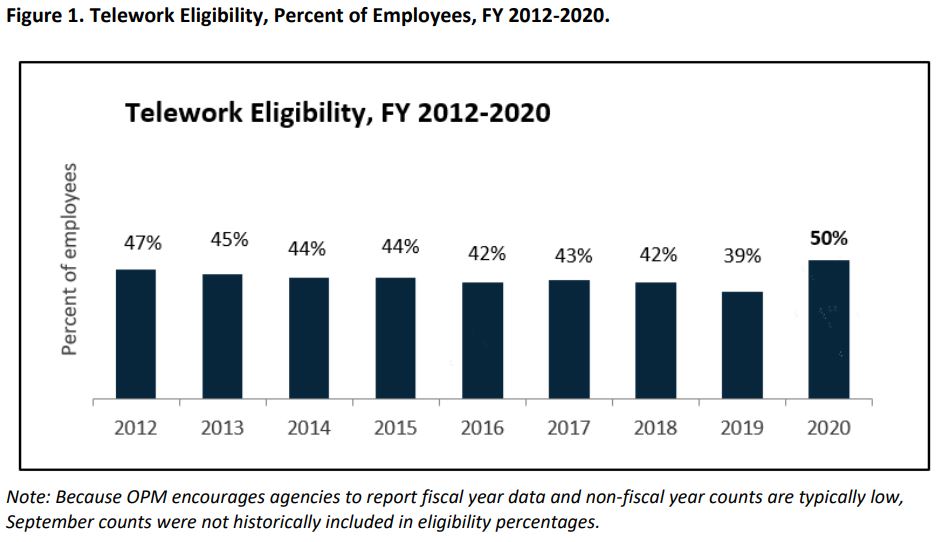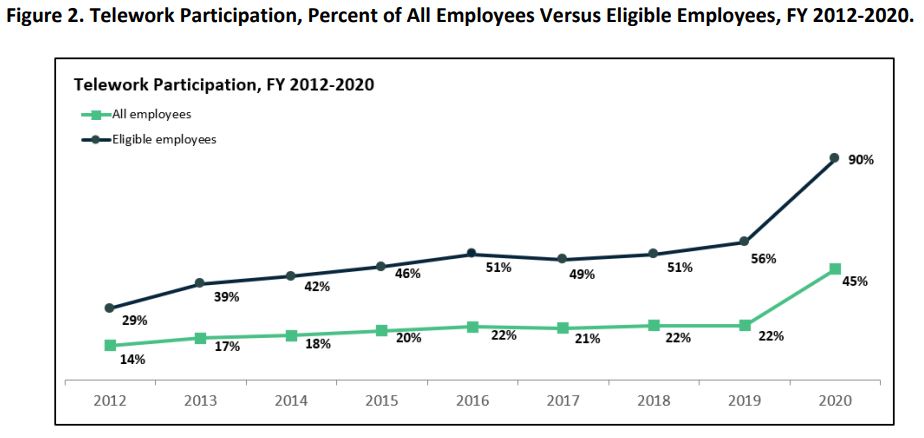Pandemic boosted federal telework participation and overall eligibility
New fiscal year data shows 2020 had the highest rates of telework participation and eligibility in nearly a decade, due mostly to the COVID-19 pandemic.
New fiscal year data shows 2020 had the highest rates of telework participation and eligibility in nearly a decade, due mostly to the COVID-19 pandemic. But the Office of Personnel Management is seeing other upward trends in the data beyond sheer telework activity.
Agencies reported 45% of all employees teleworked in 2020, compared to the approximately 22% who teleworked in both 2019 and 2018, according to OPM’s latest report to Congress. The rate was higher among those actually eligible for telework. Of those eligible to telework, 90% did so in FY 2020 compared to 56% in 2019 and 51% in 2018.
“During fiscal year 2020, agencies used telework as a strategic management tool to enhance their capability to achieve critical outcomes during an unprecedented time. Where appropriate, agencies throughout the federal government expanded telework to the maximum extent possible to protect the health and safety of the federal workforce and the American people,” OPM Director Kiran Ahuja said in the report summary.
Telework eligibility itself was on the rise as well in 2020, after dipping in 2019. Half of federal employees were telework eligible in 2020 compared to 39% in 2019 and 42% in 2018.
The data is typically released a year late, and OPM’s new report is dated December 2021. Stats were collected via an online survey to 91 agencies from Nov. 1 to Dec. 12, 2020, of which 87 responded. The report also includes “relevant findings” from the 2020 OPM Federal Employee Viewpoint Survey, which OPM said “may not be completely representative of one another” but still “allows for the reasonable assessment of correlative relationships between teleworkers’ experiences and employee outcomes.”
 OPM attributed these increases to the pandemic and policy changes, but also the agency has been encouraging organizations to set annual telework goals and measure potential cost savings for years. In 2020, 72% of agencies reported meeting their telework participation goals, or 25% more than in 2019. At the same time agencies are getting better at calculating the cost savings, which include factors such as real estate and energy costs, commuting and transit costs, training and employee absences. Sixty-four percent of agencies managed to track those savings in 2020, up from 52% in 2019.
OPM attributed these increases to the pandemic and policy changes, but also the agency has been encouraging organizations to set annual telework goals and measure potential cost savings for years. In 2020, 72% of agencies reported meeting their telework participation goals, or 25% more than in 2019. At the same time agencies are getting better at calculating the cost savings, which include factors such as real estate and energy costs, commuting and transit costs, training and employee absences. Sixty-four percent of agencies managed to track those savings in 2020, up from 52% in 2019.
OPM said agency responses indicated the federal government saved $180 million in 2020 due to telework, 40% of which was due to reduced commuting and 17% of which was because of fewer employee absences. A combined 26% of the savings came from lower utilities, rents and office space costs.
“This experience makes clear that, that when implemented correctly, telework can help us deliver on our mission,” Ahuja said. “As we look to the future, OPM is encouraging agencies to strategically leverage workplace flexibilities such as telework to help attract, recruit and retain the best possible workforce, as well as leverage telework as a way to ensure greater resiliency and emergency preparedness through the federal government.”
Copyright © 2025 Federal News Network. All rights reserved. This website is not intended for users located within the European Economic Area.
Amelia Brust is a digital editor at Federal News Network.
Follow @abrustWFED







